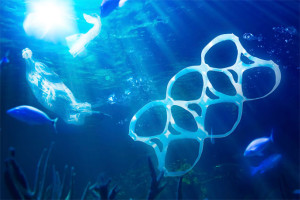In 2014, the first oceanographic study to examin e plastic debris floating near the surface of our oceans estimated that about 6.5 million tons of debris reach the oceans every year and that 60 – 80% of that is improperly discarded plastic.
e plastic debris floating near the surface of our oceans estimated that about 6.5 million tons of debris reach the oceans every year and that 60 – 80% of that is improperly discarded plastic.
Sea animals readily ingest plastic objects, such as lighters, plastic bags and toys, which often prove fatal to them. When the plastic becomes brittle and breaks down into increasingly smaller particles, it becomes available to smaller animals and the zooplankton at the bottom of the food chain.
Plastic easily binds to other pollutants, such as PCBs, which then again make their way up the food chain, at the top of which, need I remind you, are we.
A recent study found that China and Indonesia are the biggest sources of ocean-bound pollutants, jointly putting out about a third of the detritus. The United States, with a share of about 1%, came in at number 20 on the list of 192 countries examined. That’s still 65,000 tons a year, though. According to the EPA, the U.S. recycles only 7% of its plastic waste.
Plastic particles also increasingly pollute the soil, entering the food chain in that way as well. Larger items can also clog drainage systems and cause flooding. The chemicals used in the production of plastic, such as BPA, are a menace in themselves. These chemicals are known to disrupt the endocrinal system and upset the hormonal balance. Taking Vialis to counteract the effects of that only goes so far. And on top of it all, the raw material for plastics is fossil fuel.
On the other hand, plastic is wonderful stuff. You can make just about anything out of it. Its durability, while a problem with respect to the environment, can also be a very useful feature.
In any case, a world without plastic is not imaginable anymore. We just have to get better at managing it – a lot better.
The most effective way to reduce plastic pollution would seem to be using less of it, especially in packaging. In that vein, the City of Montreal, Canada, is on the verge of taking the lead among major cities in banning plastic shopping bags. And who would be sad about the extinction of the clam shell?
Almost every day new ways are invented to reuse plastic. A firm in the Netherlands has come up with a way to turn automotive dashboards and PET plastic bottles into filaments for 3D-printing. A company in Niagara Falls has even found a way to convert plastic back into petroleum. Many designers and artists use discarded plastic items as a source material for their creations and many websites offer ideas for you to do the same.
For comments and suggestions, please visit the Weekly Green Facebook page.
Oh, and by the way – please cut your six-pack O-rings before you throw them out, so they won’t strangle some little animal out there.
Have a wonderful Memorial Day!
Sources: Encyclopedia Britannica, Center for Biological Diversity, Wall Street Journal, EPA, EIA, NPR, ABC, Huffington Post, NY Times, Japan Times

